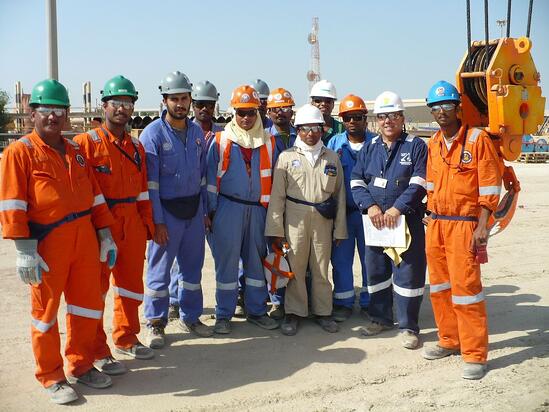
Like many US based instructors that work in the field, we face many challenges and obstacles while planning training at our facilities or at client sites. If training occurs at one of three ITI state-of-the-art training facilities, we are fortunate that we can offer a selection of ITI signature programs or tailor a program based on the needs of a client. If we need to conduct our training at a client’s site, the landscape changes and we’re now tasked to bring a specific program to the client. If that training is happening in a different country, there is an additional level of complexity to deal with. Working out of the country for ITI is not new to us as we’ve been doing this since the early 1990’s in Canada, Brazil, Nigeria and Mexico. Since 2007, we have added Australia, Netherlands, United Arab Emirates, Kingdom of Saudi Arabia, Qatar, Indonesia, Malaysia, Singapore, Democratic Republic of the Congo, Panama, and Chile. International work makes up 35% of my schedule for training and assessments (audits) for just one of our clients, McDermott International.
Just as with in-country work, when dealing with challenges in working overseas the instructor needs to have contact with the clients appointed representative(s)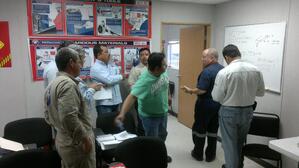 to gain as much information as possible on specifics of their site, availability of mobile or overhead cranes, rigging, company hoisting and rigging guidelines, standards they follow, safety induction requirements, classrooms, projection, and hours of program just to mention a few possible concerns. Then the fun begins; support staff packs student program materials, contents of gear boxes are accounted for, packing lists are created, materials and gear boxes are then shipped to the client’s site. Travel arrangements are now made for air, car-rental and hotels through a travel planner. Logistics change for out of country travel, including having to deal with visa requirements, and local immigration and customs requirements. Off-shore travel requirements would also include, planning for helicopter and crew boats (Huet, BOISET, and H2S Certification required). When it is time to travel, check and see if the gear boxes arrived and if not, being tracking immediately. En-route weather must be checked for possible disruption of flights; those who traveled November 2013 through February 2014 know this was no picnic for any of us. For me, I was fortunate when I traveled as it was between weather events and I did not encounter major delays or cancellations as some of my colleagues did. Do your best to have a backup plan for flight delays as this will have an effect on your clients scheduling. These are just a sampling of the trails and obstacles we face as instructors.
to gain as much information as possible on specifics of their site, availability of mobile or overhead cranes, rigging, company hoisting and rigging guidelines, standards they follow, safety induction requirements, classrooms, projection, and hours of program just to mention a few possible concerns. Then the fun begins; support staff packs student program materials, contents of gear boxes are accounted for, packing lists are created, materials and gear boxes are then shipped to the client’s site. Travel arrangements are now made for air, car-rental and hotels through a travel planner. Logistics change for out of country travel, including having to deal with visa requirements, and local immigration and customs requirements. Off-shore travel requirements would also include, planning for helicopter and crew boats (Huet, BOISET, and H2S Certification required). When it is time to travel, check and see if the gear boxes arrived and if not, being tracking immediately. En-route weather must be checked for possible disruption of flights; those who traveled November 2013 through February 2014 know this was no picnic for any of us. For me, I was fortunate when I traveled as it was between weather events and I did not encounter major delays or cancellations as some of my colleagues did. Do your best to have a backup plan for flight delays as this will have an effect on your clients scheduling. These are just a sampling of the trails and obstacles we face as instructors.
In addition, we must adapt to the environment we are in, deal with translation of local languages and dialect, and we also need to have a better understanding of who our clients are based on their nationality. We must be sensitive to their religious beliefs and cultures.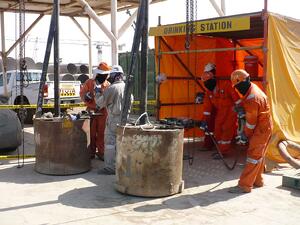 For example, typically after wire rope audits with McDermott in Jebel Ali, UAE, I schedule several rigging inspections and socketing classes at the conclusion of these audits. I bring student materials needed with me while McDermott provides remaining material necessary for these classes. Those in attendance are inspectors from Malaysia, the Philippines, Indonesia, India, and Pakistan. This creates a challenge for me with a mix of culture, language and followers of Hinduism, Christianity, and Islam. These employees do get along, and work as team members without political differences. I find that English is a second language for many employees and they are able to read and write. Pairing students who do not understand English with those that do, helps with the course translation allowing all students to better participate in classroom discussions. As an instructor, you learn how to take a different approach on lesson delivery and understand the need to be patient.
For example, typically after wire rope audits with McDermott in Jebel Ali, UAE, I schedule several rigging inspections and socketing classes at the conclusion of these audits. I bring student materials needed with me while McDermott provides remaining material necessary for these classes. Those in attendance are inspectors from Malaysia, the Philippines, Indonesia, India, and Pakistan. This creates a challenge for me with a mix of culture, language and followers of Hinduism, Christianity, and Islam. These employees do get along, and work as team members without political differences. I find that English is a second language for many employees and they are able to read and write. Pairing students who do not understand English with those that do, helps with the course translation allowing all students to better participate in classroom discussions. As an instructor, you learn how to take a different approach on lesson delivery and understand the need to be patient.
For practical examinations, hands on takes place outside in the laydown areas for cranes or quayside for wire rope socketing. The environment can be harsh, 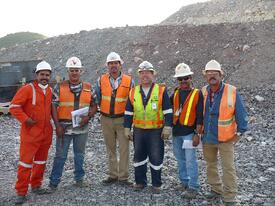 where temperatures can range from 90-110 (Fahrenheit) with little humidity. With humidity, the heat index can climb up to 130 (Fahrenheit). Concerns would be having portable shelters in place for shade, frequent breaks, and heat stress. This is a health risk for this environment. We are trained to observe others, look for signs of heat stress, and have coolers on hand with iced Gatorade. The work process can take longer than we are used to. Safety is paramount in these harsh conditions!
where temperatures can range from 90-110 (Fahrenheit) with little humidity. With humidity, the heat index can climb up to 130 (Fahrenheit). Concerns would be having portable shelters in place for shade, frequent breaks, and heat stress. This is a health risk for this environment. We are trained to observe others, look for signs of heat stress, and have coolers on hand with iced Gatorade. The work process can take longer than we are used to. Safety is paramount in these harsh conditions!
Facing Client Site Training Challenges
I was assigned a mobile crane operator class for a gold mine company in the mountains east of Hermosillo, Mexico. Communicating with my contact, they made all necessary arrangements including a translator, before my arrival. The class began with the usual introductions, then moving on to crane components and operator daily pre-start inspections with the translator speaking while I was talking. While this was taking place, I noticed some of the crane operators had blank stares on their faces as we progressed. This translator also had questions regarding the nomenclature being used; further discussion with the lead to the discovery that he was an electrician by trade, and was not familiar with crane terminology. Within the group of operators, I did find one that could speak some English to assist the electrician with crane terminology. To complicate matters, we also discovered some of the material being used had the incorrect Spanish translation. That evening after class, the electrician, crane operator and I spent four hours reviewing the mentioned translated material and load charts. We greatly improved the translation and also using pictures I had of crane components, converting them to our journal notes, we were able to identify them in the correct Spanish translation for use the next day. Class the next day went much smoother. Students recognized the efforts that were put into changing of the material and using both employees for translation. I gained their confidence by these changes in the course structure, enabling more of a two way communication between students and instructor.
In closing, I feel globally, all students are eager to learn. They have a desire for good training and appreciate the efforts of the instructors that can make adjustments and able to convey information at a level that is acceptable to them. I have a good feeling when students offer that they took something back with them that enable them to be better operators or riggers. All I ask of them is to not forget what they learned and to pay it forward to another employee.
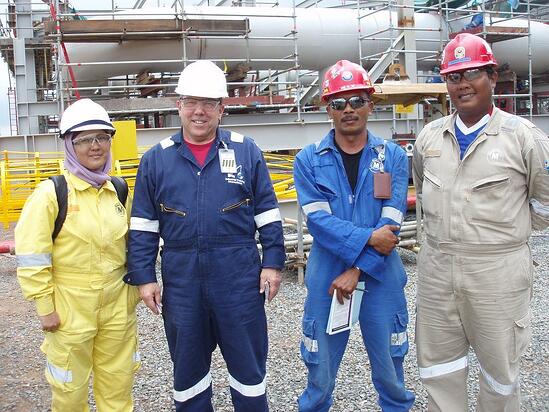

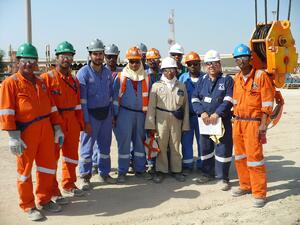
COMMENTS